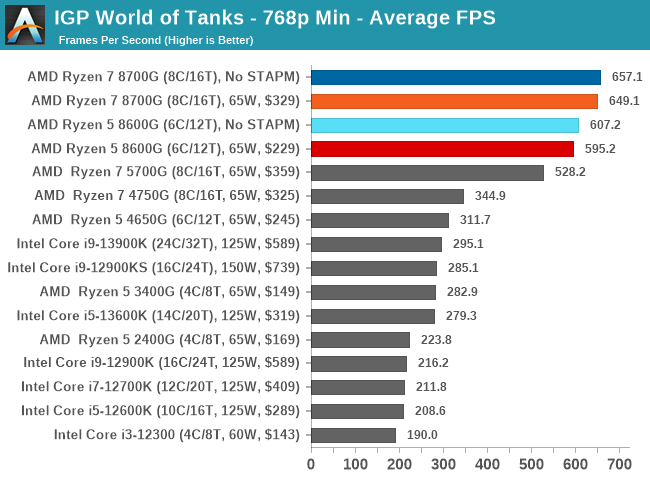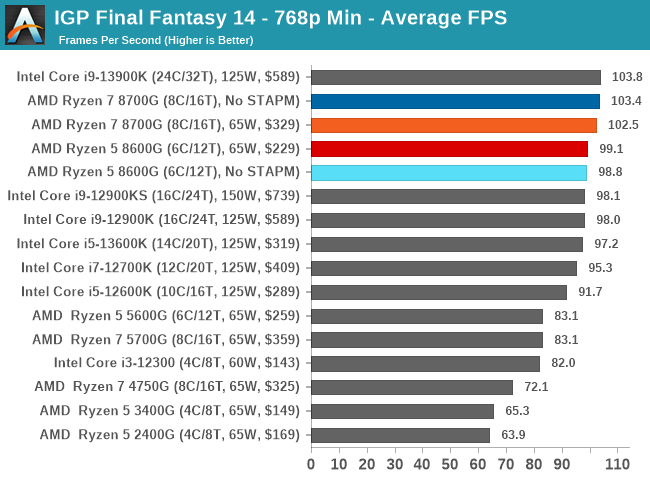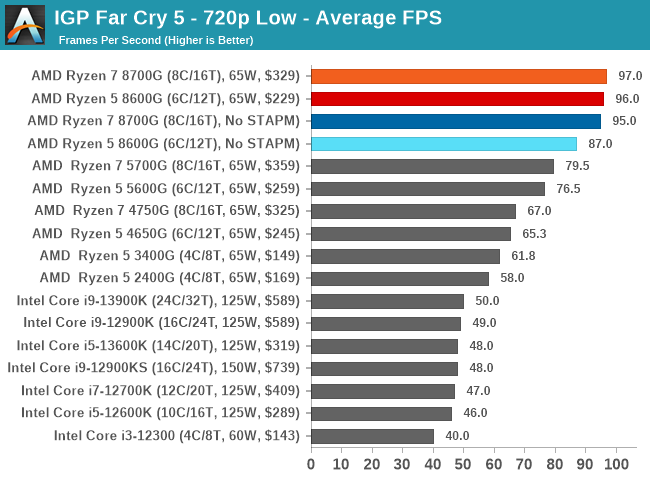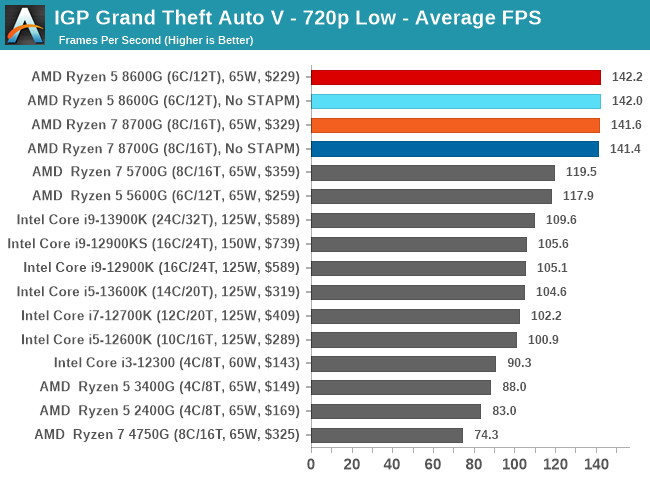AMD Ryzen 7 8700G and Ryzen 5 8600G Review: Zen 4 APUs with RDNA3 Graphics
by Gavin Bonshor on January 29, 2024 9:00 AM EST- Posted in
- CPUs
- AMD
- APUs
- Phoenix
- 4nm
- Zen 4
- RDNA3
- AM5
- Ryzen 8000G
- Ryzen 7 8700G
- Ryzen 5 8600G
iGPU Gaming Performance: 720p And Lower
The reason we test games in CPU reviews at lower resolutions such as 720p and below is simple; titles are more likely to be CPU bound than they are GPU bound at lower resolutions. This means there are more frames for the processor to process as opposed to the graphics card doing the majority of the heavy lifting.
There are some variances where some games will still use graphical power, but not as much CPU grunt at these smaller resolutions, and this is where we can show where CPU limitations lie in terms of gaming.
We are using DDR5-5200 memory as per the JEDEC specifications on the Ryzen 7 8700G and Ryzen 5 8600G, as well as DDR4-3200 on the Ryzen 7 5700G and Ryzen 5 5600G. The same methodology is also used for the AMD Ryzen 7000 series and Intel's 14th, 13th, and 12th Gen processors. Below are the settings we have used for each platform:
- DDR5-5200 CL44 - Ryzen 8000G
- DDR4-3200 CL22 - Ryzen 5000G
- DDR5-5600B CL46 - Intel 14th & 13th Gen
- DDR5-5200 CL44 - Ryzen 7000
- DDR5-4800 (B) CL40 - Intel 12th Gen





The bread and butter of AMD's Ryzen 8000G is in integrated graphics performance, with upgraded RDNA3-based mobile graphics used over AMD's aging Vegas graphics found within the Ryzen 5000G series. Depending on the title at 720p, we can see the combination of Zen 4, and RDNA3 proves much more effective at 720p than Zen 3 and Vega.
In Strange Brigade, we saw a massive 53% uplift in performance when comparing the Ryzen 7 8700G to the Ryzen 5 5700G, with the Ryzen 5 8600G also proving much more suited to gaming at 720p than any other processor with integrated graphics we've tested.
Regarding our retest with the latest firmware, we can see that both the Ryzen 7 8700G and Ryzen 5 8600G performance is marginally better at 720p. The issue with gaming benchmarks is that they typically don't represent sustained loads, and we expect these performance figures to be sustained over longer periods of time with STAPM limitations removed.










111 Comments
View All Comments
ToTTenTranz - Monday, January 29, 2024 - link
It might be worth mentioning the 8700G's larger iGPU gains almost 25% performance when paired with DDR5-6000 instead of the slower DDR5-5200:https://www.techspot.com/review/2796-amd-ryzen-870...
I don't know what advantages there are for DIY clients to hold on to JEDEC-approved speeds instead of just going with XMP and EXPO "pre-validated 1-click overclocks". Especially considering how it's only called "overclock" because JEDEC seems to take their sweet time to validate new clock/timing setups.
Slash3 - Monday, January 29, 2024 - link
The gap is likely even larger than that, as I believe HWU's 5200MT entry is still using faster XMP/Expo timings, rather than CL44 base spec. Steve simply scaled the speed for the other entries (the exception being 7200MT, which is also at Gear 2).meacupla - Monday, January 29, 2024 - link
The DDR5 RAM has to run at 1.1V to get JEDEC validation. It's not that JEDEC takes their sweet time, it is about DRAM makers not being able to produce fast DRAM.This is especially true when you want low latency.
AFAIK, the fastest JEDEC compliant DDR5 available is 6400, but with awful latency.
More so, I am surprised techspot got their chip to work at DDR5-7200. I didn't think it was possible to hit more than 6000 with any stability on the AM5 platform.
Slash3 - Monday, January 29, 2024 - link
Recent AGESA updates have made Gear 2 speeds in the 7200-8000MT range quite possible, but improvement over Gear 1 6000MT operation is fairly small due to the I/O die fabric speed being a limiting factor.These APUs are monolithic, though, so higher FCLK and MCLK/UCLK speeds are likely possible. Hopefully some reviewers and users will have time to dig into it now that the chips are officially out. I suspect we'll see some people running 6600MT in Gear 1 or 8000MT+ in Gear 2.
nandnandnand - Tuesday, January 30, 2024 - link
These APUs are bandwidth starved when it comes to iGPU performance. This review is already an outlier for using DDR5-5200, although pairing more expensive memory with 8700G/8600G doesn't make it a better choice than a CPU+discrete combo for budget users.FWhitTrampoline - Tuesday, January 30, 2024 - link
The main reason that the FCLK can get to higher rates/better FCLK:MCLK/UCLK ratios and with the proper stability on the Ryzen 8000G series APUs is because the Memory Controllers are on the same monolithic slab of silicon as the CPU cores. So there's no Cross-Module(Die to Die)/cross-clock-domain SerDes hops required there on Monolothic APUs to slow things down there. So the path from the Infinity fabric to the Memory Controllers on any Monolithic APU die based design is simpler there for APUs.thestryker - Monday, January 29, 2024 - link
JEDEC did something odd with DDR5 in that there are multiple sets of compliant latency and every maker has gone with the middle set. The lowest set is identical to DDR3/4 JEDEC compliant memory with the middle being about 14% higher. Still worse than XMP/EXPO kits as those just throw voltage through to lower latency.I'm hoping that with the 8500 DRAM Micron mentioned in a press release means maybe there will be some lower latency parts I can get for my server box.
is4u2p - Wednesday, January 31, 2024 - link
The legion Go runs 7500 RAM with the Z1 Extreme.is4u2p - Wednesday, January 31, 2024 - link
Yep, they peak around DDR5-6400 speeds, which is why you're seeing all these handhelds with 6500 or higher.barich - Wednesday, January 31, 2024 - link
DIY clients, sure. But these are going to end up in a lot of Dells and HPs, probably more by far than people who build their own. It's good to have representative benchmarks of that sort of configuration, and they'll definitely only ship JEDEC-specced RAM.Personally, I actually used Crucial's JEDEC DDR5-5600 in my 13th gen Intel build because stability is of paramount importance to me and anything higher is technically overclocking. Intel doesn't guarantee that any given CPU's memory controller will function properly faster than that. They pretty much all do, to a greater or lesser degree, but it's still a guess as to how far you can go.